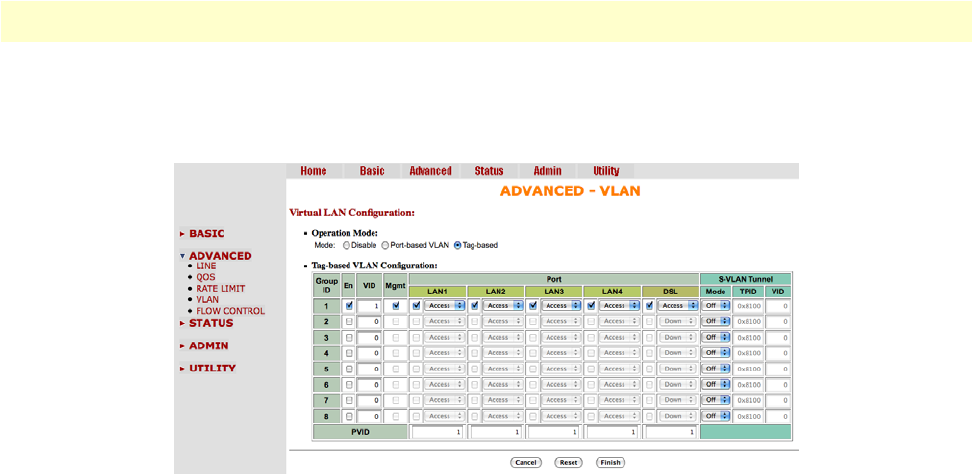
Advanced Configuration Options 45
Model 2160 Series User Manual 4 • Web configuration
802.1Q Tag-Based VLAN
Click on VLAN under Advanced on the main menu to reach the VLAN advanced configuration page. Then,
select the radio button for 802.1Q Tag-Based VLAN to display the configuration options.
Figure 16. 802.1Q Tag-Based VLAN page
• VID (Virtual LAN ID): A number to identify the VLAN segment. Select from 1 to 4094.
• PVID (Port VID): An untagged member of the default VLAN. Select from 1 to 4094.
• Link Type: Select from Access or Trunk. Access means the port can receive or send untagged packets.
Trunk means that the port can receive or send tagged packets.
In 802.1q, the VLAN information is written into the Ethernet packet itself. Each packet carries a VLAN ID
(Virtual LAN ID) called a tag. This tag allows VLANs to be configured across multiple switches.
Note
VLAN tags may be stripped by the hardware or the software.
When using 802.1q, four bytes are added to the Ethernet frame, and 12 bits are used for the VLAN ID. Theo-
retically, there can be up to 4096 VLANs per network.
An Ethernet packet that contains a VLAN ID is called a tagged packet. An Ethernet packet without a VLAN ID
is called an untagged packet. Typically, all packets leave untagged, unless tagged by the adapter prior to arriving
at the switch port.
Egress and Ingress Rules. Egress rules determine which frames can be transmitted out of a port, based on the
Egress List of the associated VLAN. Each VLAN has an Egress List that specifies the ports out of which frames
can be forwarded, and specifies whether the frames will be transmitted as tagged or untagged frames.
Ingress rules are a means of filtering out undesired traffic on a port. When Ingress Filtering is enabled, a port
determines if a frame can be processed based on whether the port is on the Egress List of the VLAN associated
with the frame.
When an untagged packet arrives at the switch port, the switch will write a VLAN ID into the header of the
frame according to the PVID (port VLAN) definition. Typically, most switches today have all ports set to a
default PVID of 1. When a tagged frame arrives at a switch port, the tag is respected.
A VID defines the member of a port group. A packet can only travel inside a member port when the member
port is part of a VID port group. Different VID groups are not visible to one another.
